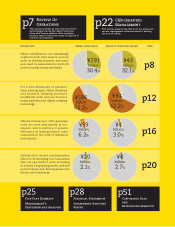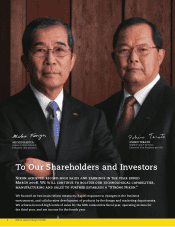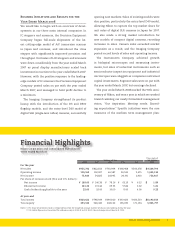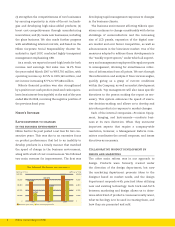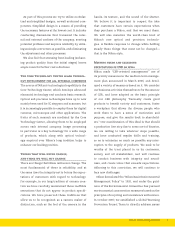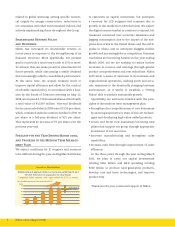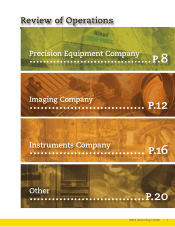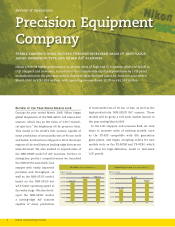Nikon 2008 Annual Report Download - page 13
Download and view the complete annual report
Please find page 13 of the 2008 Nikon annual report below. You can navigate through the pages in the report by either clicking on the pages listed below, or by using the keyword search tool below to find specific information within the annual report.
STRENGTHS
PRECISION EQUIPMENT SEGMENT ANALYSIS
The main strengths of the Precision Equipment Company
are the precision and optical technologies Nikon has
acquired over many years. These technologies have led to
the development of such products and techniques as the
NSR-S609B (NA 1.07) ArF immersion scanner, the world’s
fi rst scanner to use immersion technology to overcome
the physical limitation of an NA value over 1.0 (the physical
limitation with air as the imaging medium), the Local Fill
Nozzle to eliminate defects caused by immersion, and the
Tandem Stage that provides for both high throughput and
high precision. We have been conducting research and
development on completely new exposure technologies,
such as EUVL (extreme ultraviolet lithography), which uses
light with a wavelength 14 times shorter than the ArF lasers.
OPPORTUNITIES
New markets for digital products, including mobile
phones, MP3 players, digital cameras, personal computers
and high-defi nition televisions, are continually being cre-
ated, and develop rapidly in short periods of time. Greater
semiconductor shrinkage has of course contributed to this
development, and will continue to produce new functions,
products and industries.
Further device shrinkage means that equipment to
achieve this will be necessary for market development.
Responding to these needs for device shrinkage will be a
large key to the success of the IC steppers and scanners
business. Nikon has continued to pursue and develop
technology for shorter wavelengths and higher NA values,
creating i-line steppers, KrF scanners, as well as immersion-
type and other ArF scanners. In the year ending March
2009 we will bring to market equipment for the double
patterning process, continuing to meet customer needs for
device shrinkage.
In the LCD steppers and scanners business, a timely
response to the increasing size of LCD panels is neces-
sary. Television images are improving dramatically due
to advancements in the technology and performance of
both broadcasting and receiving equipment. The amount
of broadcasting and other media content to take advan-
tage of this technology is also increasing. As screen quality
improves and content expands, consumer needs for larger
screens will grow. The expansion of the market for large,
fl at-screen televisions is expected to drive demand for
equipment using 10th generation large glass plates. This
trend toward larger LCD panels will further enhance the
competitive advantage of Nikon’s LCD steppers and scan-
ners using the multi-lens projection optical system.
CHALLENGES
The main issue in the IC steppers and scanners business
is attaining a leading market share for cutting-edge ArF
immersion scanners, while in the LCD steppers and scan-
ners business the focus is on a timely response to larger
LCD panels.
Capital expenditures in both markets is heavily infl u-
enced by prices and demand for memory and panels, and
we consider it essential to establish a strong and fl exible
business foundation able to respond to changes in the
market environment.
Nikon Annual Report 2008 11


